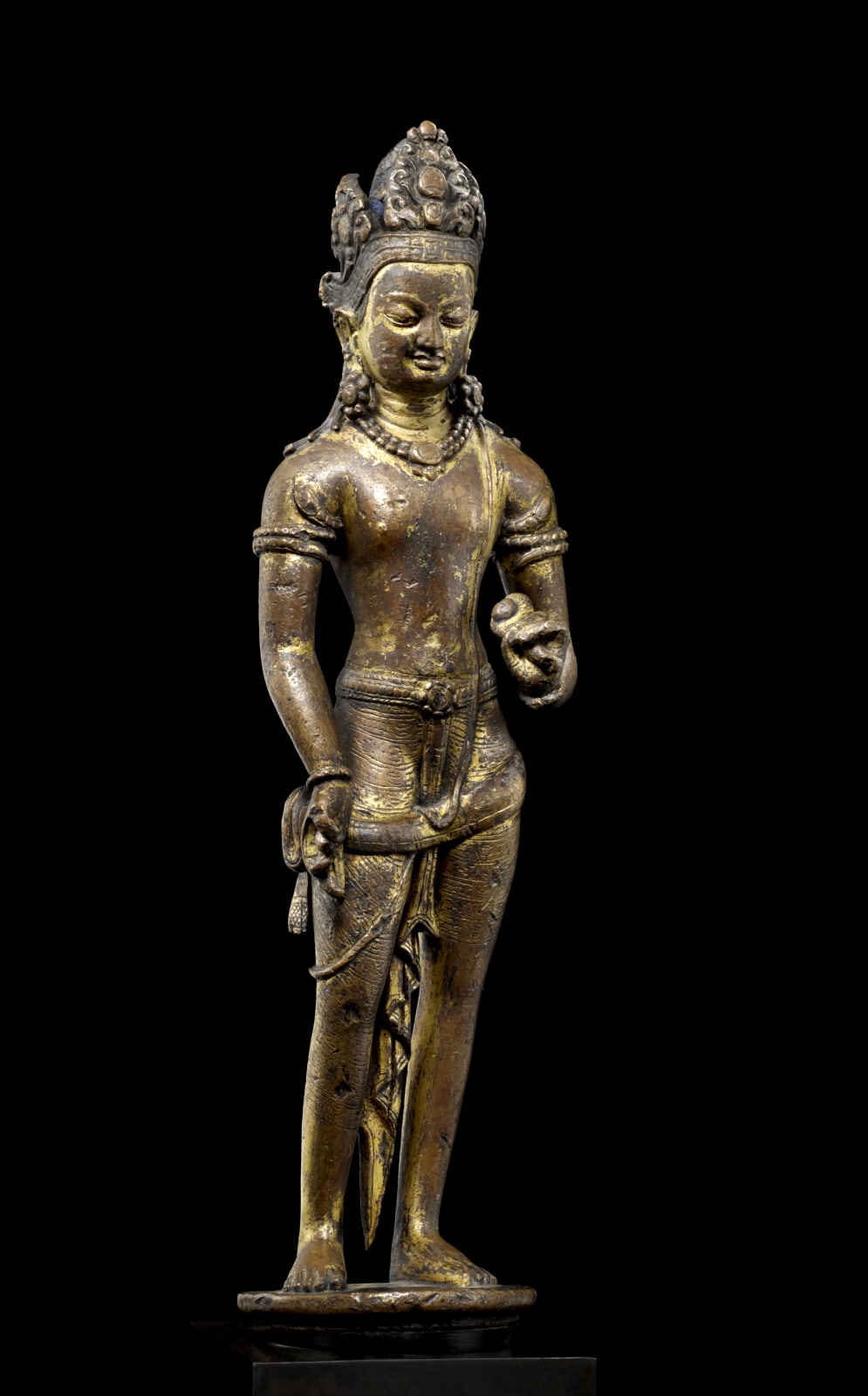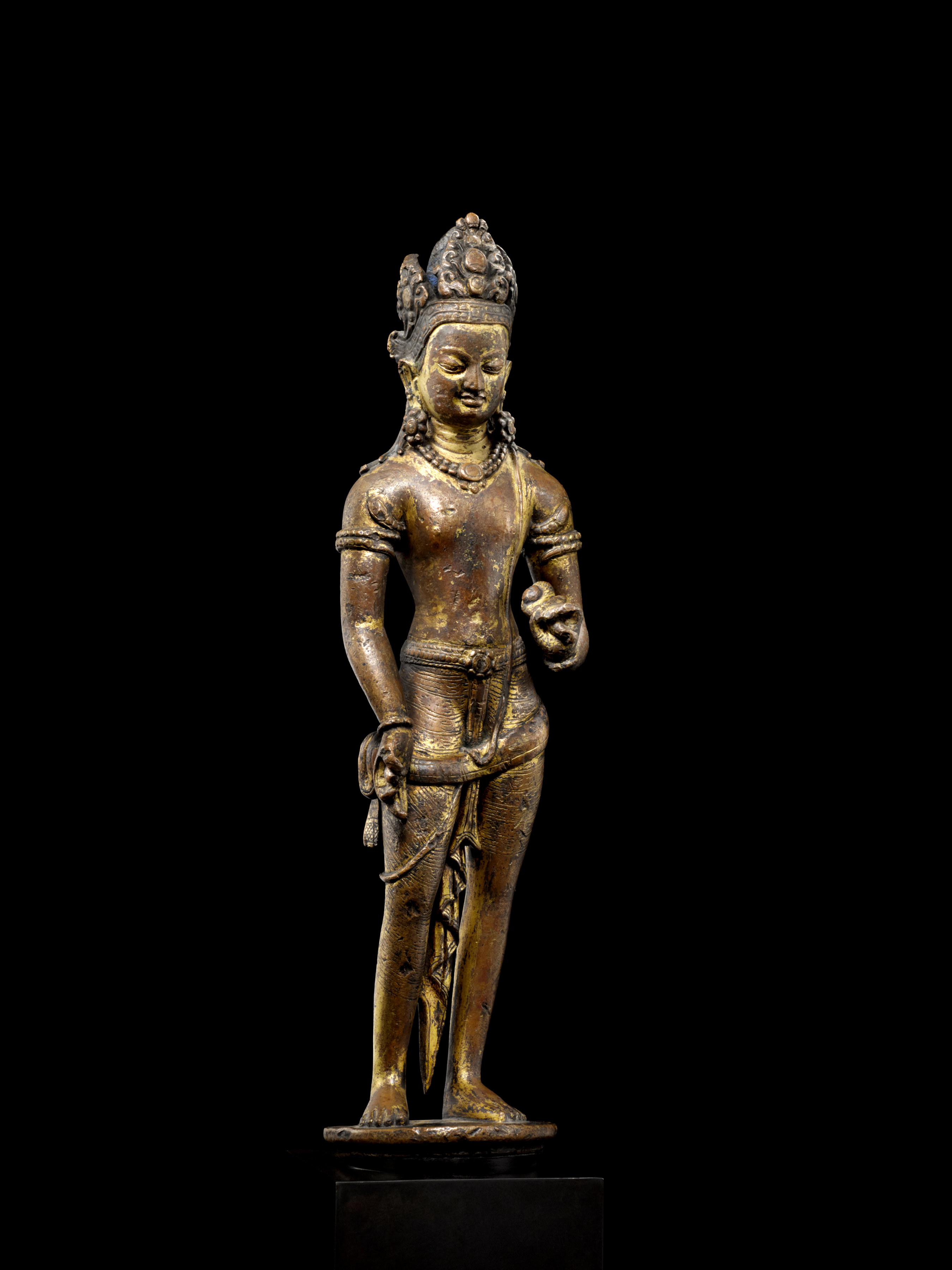
Provenance:
European Private Collection, acquired in 1993
In his raised left hand the bodhisattva holds the short stem of a flower supporting a wish-fulfilling jewel (ratna), depicted as a circular boss with a halo of radiating lines representing flames, and in the lowered right hand he holds a gemstone (mani) between thumb and forefinger. The cult of this jewel-bearing bodhisattva appears to have gained popularity in Nepal around the ninth century. At least seven other late Licchavi- and Transitional-Period (circa 880-1200) examples depict a bodhisattva with a jewel, a triple jewel (triratna), or a flaming jewel as the principal emblem: one in the Zimmerman Collection,[1] three in the Norton Simon Museum,[2] and three in Tibetan monastery collections.[3] Nepalese images of the jewel-bearing bodhisattva are not common before or after this short period between the ninth and eleventh centuries. The jewel most likely identifies the bodhisattva as Ratnapani (Jewel Bearer), whose spiritual progenitor is Ratnasambhava (Jewel Born),[4] one of the five transcendental buddhas of Vajrayana Buddhism.
The bodhisattva stands in an elegant posture with hips swaying gently to his left (abhanga), the youthful torso with broad shoulders and attenuated waist with the taut, slightly protruding abdominal musculature common in Licchavi-Period sculpture. He wears a sash tied across the thighs and fastened at the right hip (the scarf end now missing below the knot), and his face has a majestic expression displaying the classic Licchavi features of large aquiline nose and full and protruding lower lip. The sculpture is quintessentially Nepalese, cast in copper and gilded, and exhibiting classic characteristics of Kathmandu Valley Licchavi-Period sculpture. A Licchavi Avalokiteshvara, said to have been kept for centuries in Ramoche temple, Lhasa, has similar taut abdominal musculature and majestic bearing and is cast with the same type of circular plate beneath the feet to attach a pedestal.[5] Traces of gold and azurite on the neck and hair of the Ratnapani suggest that it, too, was taken to Tibet at some point, where it was painted according to Tibetan ritual practice.
The Licchavi dynasty originated in India, used Sanskrit as a court language, and even issued Indian-style coins. It maintained close ties to India and while also having economic and political relations with Tibet, thus becoming a cultural center linking central and southern Asia.
1 Pratapaditya Pal, Art of the Himalayas: Treasures from Nepal and Tibet, New York, 1991, p. 43, cat. no 7
2 Pratapaditya Pal, Art from the Himalayas & China, New Haven and London, 2003, pp. 70-71, cat. no. 41
(identified as Avalokiteshvara [?], but previously tentatively identified as Ratnapani, see Pal, “Sculptures to Make You Marvel: Some Himalayan Bronzes in the Norton Simon Museum,” Orientations 27, no. 7 (July-August), pp. 18-29); ibid., pp. 72-73, cat. no. 42; ibid., p. 77, cat. no. 46
3 Ulrich von Schroeder, Buddhist Sculptures in Tibet, Hong Kong, 2001, Vol. I, p. 462, pls. 142A-C (identified as Cintamani Avalokiteshvara [?])
4 Pal, 1991, op. cit., p. 43
5 Pratapaditya Pal, Himalayas: An Aesthetic Adventure, Art Institute of Chicago exhibition catalogue, 2003, p. 25, cat. no. 2

